#email list building tutorial
Explore tagged Tumblr posts
Text
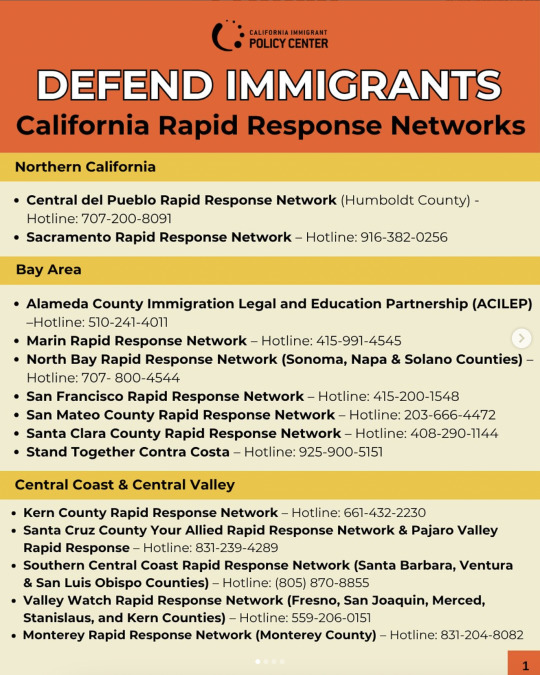
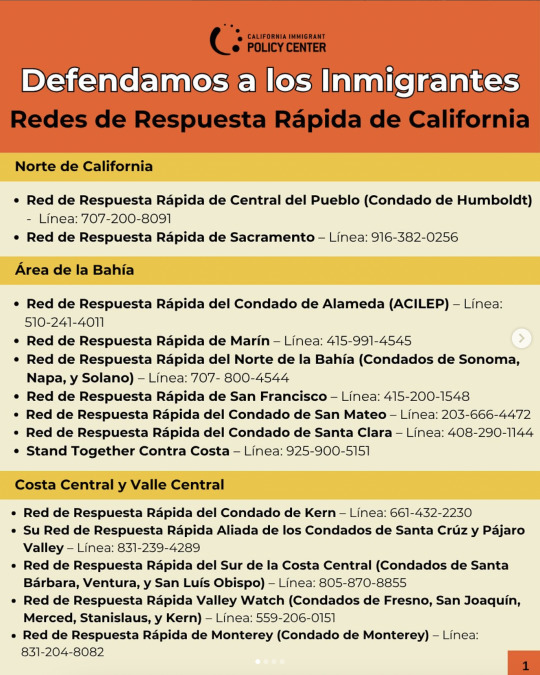
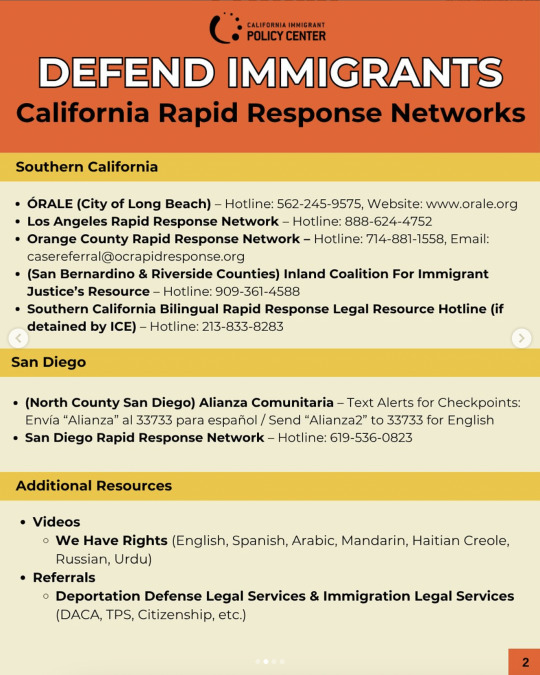





California Rapid Response Networks
These graphics are from the California Immigrant Policy Center instagram but you can find the same information with hyperlinks on their website (copied as a transcript below the cut).
California Rapid Response Networks
Northern California
Central del Pueblo Rapid Response Network (Humboldt County) – 707-200-8091
Sacramento Rapid Response Network – Hotline: 916-382-0256
Bay Area
Alameda County Immigration Legal and Education Partnership (ACILEP) – Hotline: 510-241-4011
Marin Rapid Response Network – Hotline: 415-991-4545
North Bay Rapid Response Network (Sonoma, Napa & Solano Counties) – Hotline: 707- 800-4544
San Francisco Rapid Response Network – Hotline: 415-200-1548
San Mateo County Rapid Response Network – Hotline: 203-666-4472
Santa Clara County Rapid Response Network – Hotline: 408-290-1144
Stand Together Contra Costa – Hotline: 925-900-5151
Central Coast & Central Valley
Kern County Rapid Response Network – Hotline: 661-432-2230
Monterey County Solidarity Network – Hotline: 831-204-8082
Santa Cruz County Your Allied Rapid Response Network – Hotline: 831-239-4289
805 Immigrant Rapid Response Network (Santa Barbara, Ventura & San Luis Obispo Counties) – Hotline: (805) 870-8855
Valley Watch Rapid Response Network (San Joaquin, Stanislaus, Merced, Madera, Tulare, Kings, Kern) – 559-206-0151
Southern California
Long Beach Community Defense Network – Hotline: 562-245-9575
Los Angeles Rapid Response Network – Hotline: 888-624-4752
Orange County Rapid Response Network – Hotline: 714-881-1558, Email: [email protected]
(San Bernardino & Riverside Counties) Inland Coalition For Immigrant Justice’s Resource – Hotline: 909-361-4588
Southern California Bilingual Rapid Response Legal Resource Hotline (if detained by ICE) – Hotline: 213-833-8283
San Diego
(North County San Diego) Alianza Comunitaria – Text Alerts for Checkpoints: Envía “Alianza” al 33733 para español / Send “Alianza2” to 33733 for English
San Diego Rapid Response Network – Hotline: 619-536-0823
Additional Resources:
Videos: We Have Rights (English, Spanish, Arabic, Mandarin, Haitian Creole, Russian, Urdu)
Referrals: Deportation Defense Legal Services –
Referrals: Immigration Legal Services (DACA, TPS, Citizenship, etc.)
Know Your Rights Resources
Know Your Rights Materials
Know Your Rights Under the US Constitution – No Matter Who is President (NILC)
A know-your-rights handout in eight languages to help families prepare for a possible interaction with ICE
A Know Your Rights Toolkit by ILRC includes handouts, family preparedness plans and a train-the-trainer toolkit
Printable ILRC red cards in to distribute to community members (Spanish here)
Know-Your-Rights tutorial videos in 7 languages to help prepare individuals for encounters with Immigration & Customs Enforcement (ICE) (Spanish here)
CLINIC Know Your Rights flyers
WeHaveRights – Creating an Emergency Plan
Noncitizen Protest Protection: 10 Things Noncitizen Protestors Need to Know
KYR / Community Education Preparedness Resources (NIPNLG)
Know Your Rights and Creating Safe Spaces Resource List (NILC)
Know Your Rights Resources (NIJC)
KYR Community Education Materials:
KYR / Community Education Preparedness – Curated Resources (NIPNLG)
KYR Flyer – English (NPNA)
KYR Graphics – English (NPNA)
KYR Community Education Presentation – English
KYR Community Education Presentation – Spanish
Train the Trainer KYR Presentation Outline (1 Hour) – English
Train the Trainer KYR Presentation Outline (1 Hour) – Spanish
ILRC Know Your Rights Train the Trainer Toolkit
TRP Immigrant Justice KYR Resources
NAKASEC Resources & Know Your Rights App
Family Preparedness
ILRC Family Preparedness Plan (English / Spanish)
Family Preparedness Plan (TIRRC)
Appleseed Manual on Protecting Assets
Family Preparedness 2 Pager (NPNA)
Family Preparedness 2 Pager – Spanish (NPNA)
Family Preparedness Graphic Carousel (NPNA)
Deportation & Removal Defense
Building Community-Driven Legal Services to Empower, Protect, and Defend Our Communities: Field Guide for Deportation Defense
Deportation Defense Manual (Make the Road NY)
Community FAQ: What Do We Expect at the Beginning of Trump 2.0 & How You Can Get Prepared (NIPNLG)
155 notes
·
View notes
Text
Creating a personal fanfic archive using Calibre, various Calibre plugins, Firefox Reader View, and an e-Reader / BookFusion / Calibre-Web
A few years ago I started getting serious about saving my favorite fic (or just any fic I enjoyed), since the Internet is sadly not actually always forever when it comes to fanfiction. Plus, I wanted a way to access fanfic offline when wifi wasn't available. Enter a personal fanfic archive!
There are lots of ways you can do this, but I thought I'd share my particular workflow in case it helps others get started. Often it's easier to build off someone else's workflow than to create your own!
Please note that this is for building an archive for private use -- always remember that it's bad form to publicly archive someone else's work without their explicit permission.
This is going to be long, so let's add a read more!
How to Build Your Own Personal Fanfic Archive
Step One: Install Calibre
Calibre is an incredibly powerful ebook management software that allows you to do a whole lot of stuff having to do with ebooks, such as convert almost any text-based file into an ebook and (often) vice-versa. It also allows you to easily side-load ebooks onto your personal e-reader of choice and manage the collection of ebooks on the device.
And because it's open source, developers have created a bunch of incredibly useful plugins to use with Calibre (including several we're going to talk about in the next step), which make saving and reading fanfiction super easy and fun.
But before we can do that, you need to download and install it. It's available for Windows, MacOS, Linux, and in a portable version.
Step Two: Download These Plugins
This guide would be about 100 pages long if I went into all of the plugins I love and use with Calibre, so we're just going to focus on the ones I use for saving and reading fanfiction. And since I'm trying to keep this from becoming a novel (lolsob), I'll just link to the documentation for most of these plugins, but if you run into trouble using them, just tag me in the notes or a comment and I'll be happy to write up some steps for using them.
Anyway, now that you've downloaded and installed Calibre, it's time to get some plugins! To do that, go to Preferences > Get plugins to enhance Calibre.
You'll see a pop-up with a table of a huge number of plugins. You can use the Filter by name: field in the upper right to search for the plugins below, one at a time.
Click on each plugin, then click Install. You'll be asked which toolbars to add the plugins to; for these, I keep the suggested locations (in the main toolbar & when a device is connected).
FanFicFare (here's also a great tutorial for using this plugin) EpubMerge (for creating anthologies from fic series) EbubSplit (for if you ever need to break up fic anthologies) Generate Cover (for creating simple artwork for downloaded fic) Manage Series (for managing fic series)
You'll have to restart Calibre for the plugins to run, so I usually wait to restart until I've installed the last plugin I want.
Take some time here to configure these plugins, especially FanFicFare. In the next step, I'll demonstrate a few of its features, but you might be confused if you haven't set it up yet! (Again, highly recommend that linked tutorial!)
Step Three: Get to Know FanFicFare (and to a lesser extent, Generate Cover)
FanFicFare is a free Calibre plugin that allows you to download fic in bulk, including all stories in a series as one work, adding them directly to Calibre so that that you can convert them to other formats or transfer them to your e-reader.
As with Calibre, FanFicFare has a lot of really cool features, but we're just going to focus on a few, since the docs above will show you most of them.
The features I use most often are: Download from URLs, Get Story URLs from Email, and Get Story URLs from Web Page.
Download from URLs let's you add a running list of URLs that you'd like FanFicFare to download and turn into ebooks for you. So, say, you have a bunch of fic from fanfic.net that you want to download. You can do that!

Now, in this case, I've already downloaded these (which FanFicFare detected), so I didn't update my library with the fic.
But I do have some updates to do from email, so let's try getting story URLs from email!
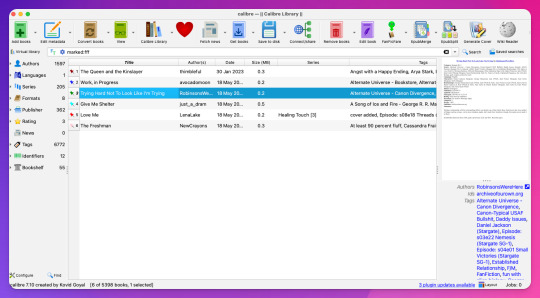
Woohoo, new fic! Calibre will detect when cover art is included in the downloaded file and use that, but at least one of these fic doesn't have cover art (which is the case for most of the fic I download). This is where Generate Cover comes in.
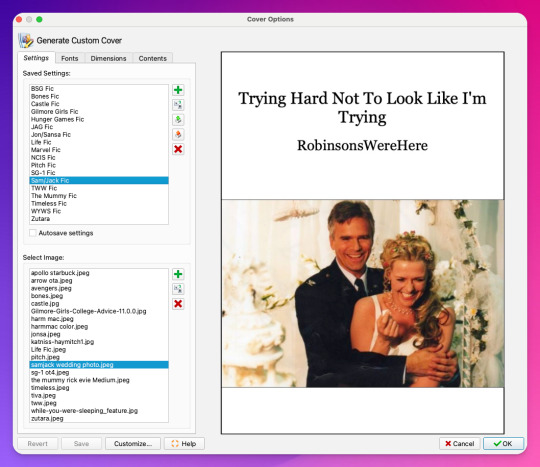
With Generate Cover, I can set the art, font, dimensions, and info content of the covers so that when I'm looking at the fic on my Kindle, I know right away what fic it is, what fandom it's from, and whether or not it's part of a series.
Okay, last thing from FanFicFare -- say I want to download all of the fic on a page, like in an author's profile on fanfic.net or all of the stories in a series. I can do that too with Get Story URLs from Web Page:

The thing I want to call out here is that I can specify whether the fic at this link are individual works or all part of an anthology, meaning if they're all works in the same series, I can download all stories as a single ebook by choosing For Anthology Epub.
Step Four: Using FireFox Reader View to Download Fic Outside of Archives
This is less common now thanks to AO3, but the elders among us may want to save fanfic that exists outside of archives on personal websites that either still exist or that exist only on the Internet Wayback Machine. FanFicFare is awesome and powerful, but it's not able to download fic from these kinds of sources, so we have to get creative.
I've done this in a couple of ways, none of which are entirely perfect, but the easiest way I've found thus far is by using Firefox's Reader View. Also, I don't think I discovered this -- I think I read about this on Tumblr, actually, although I can longer find the source (if you know it, please tell me so I can credit them!).
At any rate, open the fic in Firefox and then toggle on Reader View:
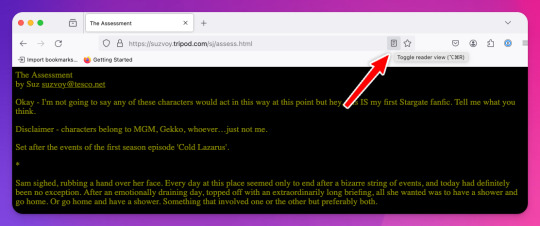
Toggling on Reader View strips all the HTML formatting from the page and presents the fic in the clean way you see in the preview below, which is more ideal for ebook formats.
To save this, go to the hamburger menu in the upper right of the browser and select Print, then switch to Print to PDF. You'll see the URL and some other stuff at the top and bottom of the pages; to remove that, scroll down until you see something like More settings... and uncheck Print headers and footers.
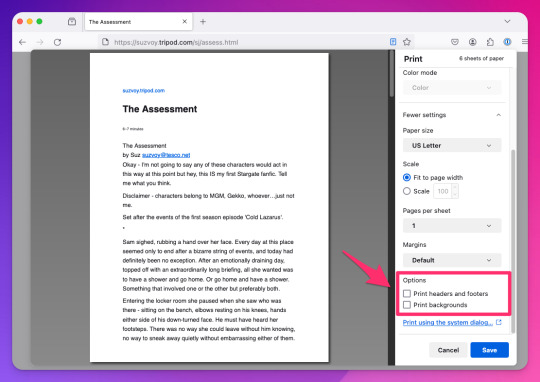
Click Save to download the resulting PDF, which you can then add to Calibre and convert to whichever format works best for your e-reader or archive method.
Step Five: Archiving (Choose Your Own Adventure)
Here's the really fun part: now that you know how to download your fave fanfics in bulk and hopefully have a nice little cache going, it's time to choose how you want to (privately) archive them!
I'm going to go through each option I've used in order of how easy it is to implement (and whether it costs additional money to use). I won't go too in depth about any of them, but I'm happy to do so in a separate post if anyone is interested.
Option 1: On Your Computer
If you're using Calibre to convert fanfic, then you're basically using your computer as your primary archive. This is a great option, because it carries no additional costs outside the original cost of acquiring your computer. It's also the simplest option, as it really doesn't require any advanced technical knowledge, just a willingness to tinker with Calibre and its plugins or to read how-to docs.
Calibre comes with a built-in e-book viewer that you can use to read the saved fic on your computer (just double-click on the fic in Calibre). You can also import it into your ebook app of choice (in most cases; this can get a little complicated just depending on how many fic you're working with and what OS you're on/app you're using).
If you choose this option, you may want to consider backing the fic up to a secondary location like an external hard drive or cloud storage. This may incur additional expense, but is likely still one of the more affordable options, since storage space is cheap and only getting cheaper, and text files tend to not be that big to begin with, even when there are a lot of them.
Option 2: On Your e-Reader
This is another great option, since this is what Calibre was built for! There are some really great, afforable e-readers out there nowadays, and Calibre supports most of them. Of course, this is a more expensive option because you have to acquire an e-reader in addition to a computer to run Calibre on, but if you already have an e-reader and haven't considered using it to read fanfic, boy are you in for a treat!
Option 3: In BookFusion
This is a really cool option that I discovered while tinkering with Calibre and used for about a year before I moved to a self-hosted option (see Option 4).
BookFusion is a web platform and an app (available on iOS and Android) that allows you to build your own ebook library and access it from anywhere, even when you're offline (it's the offline bit that really sold me). It has a Calibre plugin through which you can manage your ebook library very easily, including sorting your fanfic into easy-to-access bookshelves. You may or may not be able to share ebooks depending on your subscription, but only with family members.
Here's what the iOS app looks like:
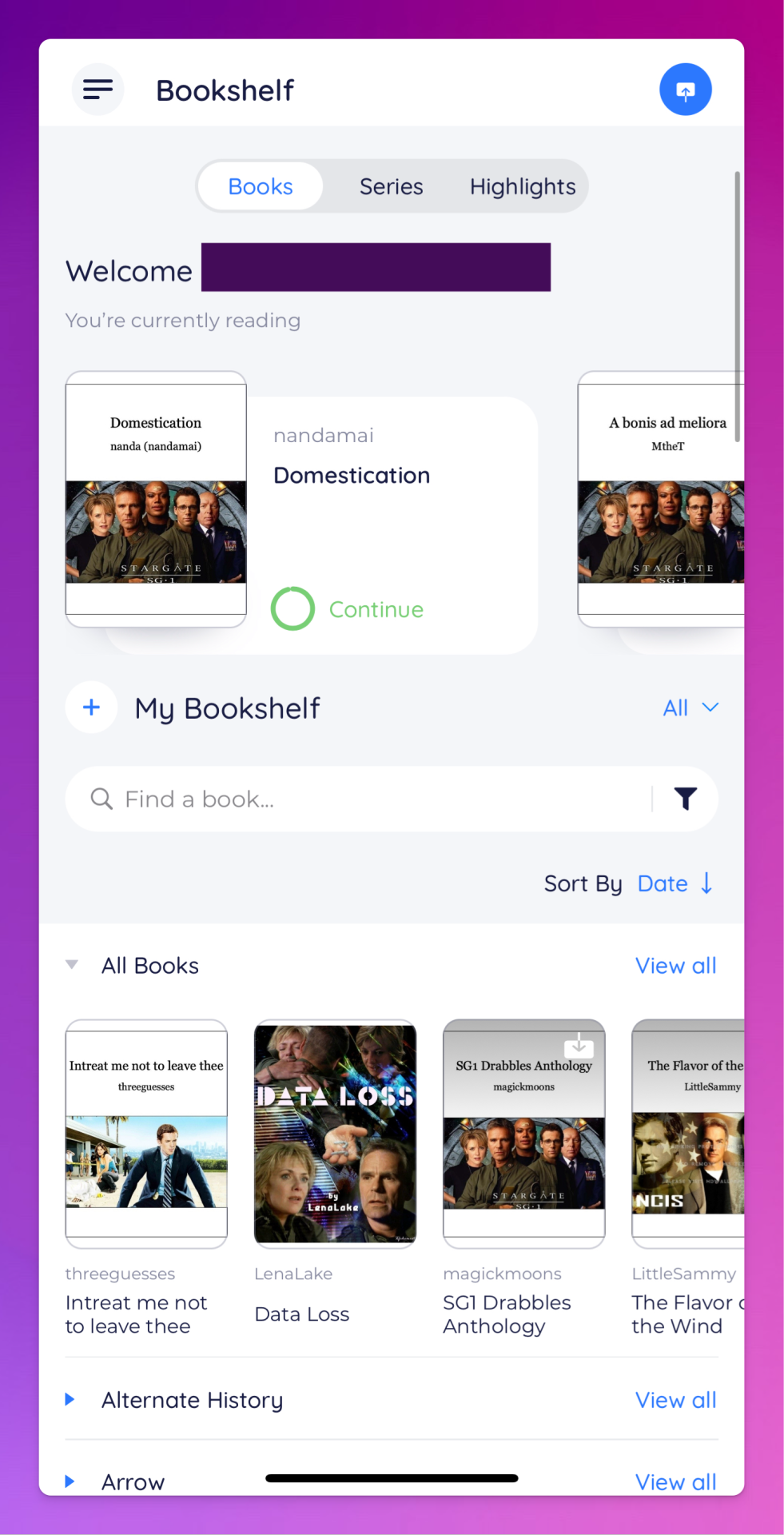
The downside to BookFusion is that you'll need a subscription if you want to upload more than 10 ebooks. It's affordable(ish), ranging from $1.99 per month for a decent 5GB storage all the way to $9.99 for 100GB for power users. Yearly subs range from $18.99 to $95.99. (They say this is temporary, early bird pricing, but subscribing now locks you into this pricing forever.)
I would recommend this option if you have some cash to spare and you're really comfortable using Calibre or you're a nerd for making apps like BookFusion work. It works really well and is incredibly convenient once you get it set up (especially when you want to read on your phone or tablet offline), but even I, someone who works in tech support for a living, had some trouble with the initial sync and ended up duplicating every ebook in my BookFusion library, making for a very tedious cleanup session.
Option 4: On a Self-Hosted Server Using Calibre-Web
Do you enjoy unending confusion and frustration? Are you okay with throwing fistfuls of money down a well? Do you like putting in an incredible amount of work for something only you and maybe a few other people will ever actually use? If so, self-hosting Calibre-Web on your own personal server might be a good fit for you!
To be fair, this is likely an experience unique to me, because I am just technical enough to be a danger to myself. I can give a brief summary of how I did this, but I don't know nearly enough to explain to you how to do it.
Calibre-Web is a web app that works on top of Calibre, offering "a clean and intuitive interface for browsing, reading, and downloading eBooks."
I have a network-attached storage (NAS) server on which I run an instance of Calibre and Calibre-Web (through the miracle that is Docker). After the initial work of downloading all the fic I wanted to save and transferring it to the server, I'm now able to download all new fic pretty much via email thanks to FanFicFare, so updating my fic archive is mostly automated at this point.
If you're curious, this is what it looks like:
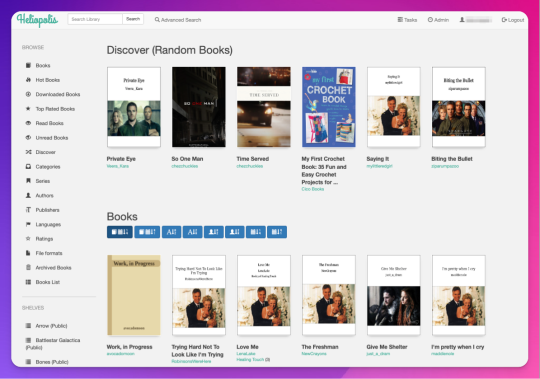
Pros: The interface is clean and intuitive, the ebook reader is fantastic. The Discover feature, in which you are given random books / fic to read, has turned out to be one feature worth all the irritation of setting up Calibre-Web. I can access, read, and download ebooks on any device, and I can even convert ebooks into another format using this interface. As I mentioned above, updating it with fic (and keeping the Docker container itself up to date) is relatively automated and easy now.
Cons: The server, in whichever form you choose, costs money. It is not cheap. If you're not extremely careful (and sometimes even if you are, like me) and a hard drive goes bad, you could lose data (and then you have to spend more money to replace said hard drive and time replacing said data). It is not easy to set up. You may, at various points in this journey, wish you could launch the server into the sun, Calibre-Web into the sun, or yourself into the sun.
Step Six: Profit!
That's it! I hope this was enough to get you moving towards archiving your favorite fanfic. Again, if there's anything here you'd like me to expand on, let me know! Obviously I'm a huge nerd about this stuff, and love talking about it.
#genie's stuff#calibre#calibre-web#bookfusion#personal fanfic archive#archiving fanfic#saving fanfic
103 notes
·
View notes
Text




I'll be adding three listings to the Yarn Cosplay Guild Pride Auction fundraising for The Trevor Project ! (psst, YOU could help me make #3 even cooler!)
🌈First, we have a commission for a plushie/prop/accessory of a value of $300 or more! This is a great opportunity to get a commission from me because they are super limited due to my intensely packed schedule!
🌈Next, a chance to decide what content gets put out first from my massive backlog of educational content to make. There are so many projects I've done with so many people eager for a tutorial. This is your chance to let me know that you really want a certain project to get the deep dive I am writing for it asap! While I will make the educational video and blog posts free to the public, to support future educational series I will be offering a build book full of even more notes, charts, and pictures to those interested and able to support my work. The winner of this item will receive this too!
🌈Finally, we are doing a huge pattern bundle. I'll be adding both my Guillotine purse pattern and my Spidey crop patter. I'm still taking pattern donations, so if you are interested please email a pdf of your pattern with pictures to promote to [email protected] *Patterns will be erased from my computer after the auction winner receives them!
I am so excited to be able to donate my work to this auction. This is such a meaningful way to celebrate Pride month! If you are interested in donating a physical or digital good to the auction before June 1st, please submit this form.
The auction runs the first two weeks of June!
#pride#pride month#yarn cosplay#yarn cosplay guild#cosplay#cosplayer#crochet#crocheter#crochetblr#crochet cosplay#crochet pattern#fiber artist#queer#queer artist#yarn#crochet tutorials#crochet reference#crochet inspo
18 notes
·
View notes
Text
Proven Marketing Tactics for Small Business Success
Marketing is the lifeblood of any enterprise, especially small groups seeking to grow and compete in a crowded market. Without powerful advertising strategies, even the satisfactory products or services can pass overlooked. Unlike huge companies, small companies often operate with restrained budgets and resources. Therefore, they need clever, price-effective, and measurable strategies to advantage visibility and develop step by step.
Best marketing strategies for small business

This article explores numerous marketing techniques that are especially effective for small agencies, combining traditional strategies with modern digital tools.
1. Understand Your Target Audience
The basis of all advertising begins with know-how your clients. Define your target marketplace based totally on:
Demographics: Age, gender, profits stage, education
Geographics: Where they stay or paintings
Psychographics: Lifestyle, pursuits, and values
Behavioral trends: Buying conduct, logo loyalty, product utilization
Creating a purchaser persona enables you tailor your messaging, offers, and channels greater correctly. For instance, in case you're concentrated on university college students, Instagram and TikTok is probably better platforms than electronic mail advertising or print media.
2. Build a Strong Brand Identity
A recognizable and straightforward emblem builds lengthy-time period customer loyalty. Your brand includes:
Logo and design: Consistent shades, fonts, and imagery
Tone of voice: Formal, informal, funny, and so on.
Even a one-man or woman enterprise blessings from sturdy branding. For example, a nearby baker who uses eco-friendly packaging can emblem themselves as “inexperienced” and attract environmentally-conscious customers.
Three. Create a Professional Website
A internet site is your 24/7 digital storefront. It should be:
Mobile-friendly and fast
Easy to navigate
Linked for your social media pages
Equipped with touch paperwork or chat help
Use platforms like WordPress, Wix, or Shopify to create low priced, attractive websites without requiring technical expertise.
Four. Utilize Local search engine marketing
If you’re a nearby commercial enterprise, optimizing your on-line presence for local searches is critical. Start by using:
Claiming and verifying your Google Business Profile
Encouraging satisfied clients to depart reviews
Using local key phrases (e.G., “nice salon in Patna”)
Getting indexed in neighborhood directories and maps
5. Leverage Social Media Marketing
Social media structures offer unfastened and paid tools to interact your target audience and construct a community.
Facebook & Instagram: Great for promotions, memories, and visible content
LinkedIn: Best for B2B organizations
YouTube: Ideal for tutorials, product demos, and at the back of-the-scenes content
X (previously Twitter): Good for quick updates, client interplay
Use content material calendars to time table posts always and engage with followers through polls, contests, and comments.
6. Content Marketing: Educate and Add Value
Rather than simply promoting, content material advertising goals to teach and construct accept as true with. Examples encompass:
Blog posts: Informative articles in your internet site
E-books & Guides: Offer beneficial records in alternate for electronic mail addresses
Videos: Product demonstrations, testimonials, or storytelling
Infographics: Shareable visuals explaining complicated topics
Content advertising improves search engine marketing, establishes authority, and builds long-term trust.
7. Email Marketing
Email remains one of the most price-powerful channels for small corporations. Use it to:
Send newsletters
Announce promotions or new merchandise
Re-engage inactive customers
Request remarks
Tools like Mailchimp, Sendinblue, and ConvertKit allow smooth automation and list segmentation. Ensure your emails offer fee, no longer just commercials.
Eight. Referral and Loyalty Programs
Your glad clients can be your excellent marketers. Encourage them to refer friends or family with the aid of offering:
Discounts
Free products
Loyalty points
#digital marketing#online and offline sales#online and offline business#method of small business#Best marketing strategies for small business
3 notes
·
View notes
Text
How to Build a Strong Personal Brand Online in 2025
In today’s digital age, your personal brand is often your most valuable asset. Whether you're a freelancer, entrepreneur, coach, content creator, or job seeker—building a powerful online presence can open doors, generate income, and create influence. In 2025, personal branding has gone beyond fancy bios and selfies. It’s about authenticity, authority, and consistency across platforms.
This guide will show you step-by-step how to build a personal brand online that attracts opportunities and earns trust in an increasingly noisy digital space.
Why Personal Branding Matters More Than Ever
The internet is saturated. Every niche is crowded. If you don’t stand out, you disappear.
But a strong personal brand:
Positions you as an expert in your field
Attracts clients, partnerships, or job offers
Builds trust and community
Helps you charge more for your time and services
Whether you're starting from scratch or refining your online image, a clear brand can be your biggest differentiator.
Step 1: Define Your Personal Brand Identity
Before posting content or building a website, get crystal clear on who you are and what you stand for.
Ask yourself:
What’s my mission or purpose?
What problems do I help people solve?
What are my values and beliefs?
What kind of audience do I want to attract?
This identity will influence your content, visuals, tone of voice, and positioning.
Pro Tip: A digital marketing consultant can help you craft a brand message that feels authentic and resonates with your ideal audience.
Step 2: Optimize Your Online Presence
Once you’ve defined your brand, your next goal is to align your online profiles with your message. That includes:
A professional profile photo
Consistent username/handle across platforms
A powerful, clear bio (who you help and how)
Links to your website, portfolio, or landing page
Focus on platforms where your audience hangs out—LinkedIn, Instagram, Twitter (X), YouTube, or your own website.
Need help building a stunning personal website? Work with a website development team that knows how to make your brand shine online.
Step 3: Create Valuable, Branded Content
Content is the engine that drives your brand. To gain visibility and trust, post content that provides value consistently.
Content types:
Educational posts (tips, how-tos, tutorials)
Opinion pieces or thought leadership
Behind-the-scenes or personal journey updates
Video content (vlogs, reels, YouTube shorts)
Live streams or podcasts
Create 3–5 content pillars that relate to your brand and rotate them weekly. Consistency builds recognition and loyalty.
Want a content calendar made just for you? Hire a social media expert to create, schedule, and manage content tailored to your goals.
Step 4: Build Credibility Through Social Proof
No matter how great your message is, people want proof that you’re legit.
Ways to build social proof:
Testimonials from clients or peers
Screenshots of positive feedback or results
Interviews or podcast guest appearances
Case studies or before-after transformations
Press mentions or awards
Even if you're just starting out, document small wins and share your growth journey. It builds relatability and authenticity.
If you want your brand to be seen by media outlets or featured on popular platforms, collaborate with a PR and branding agency that can get you noticed.
Step 5: Network and Collaborate
Your brand doesn’t grow in a bubble. The fastest way to grow your audience and credibility is through collaborations and relationships.
Try this:
Engage daily with your niche community
Comment meaningfully on others’ posts
Join Twitter/X Spaces, Clubhouse rooms, or LinkedIn groups
Collaborate on content, giveaways, or interviews
The more you're seen associating with other credible people, the stronger your personal brand becomes.
Step 6: Offer Something of Value (Lead Magnet)
Want to grow an email list or attract leads? Give something away in exchange for contact info.
Ideas:
Free guide or checklist
Ebook or mini-course
Exclusive newsletter or training
Templates or tools
Place it on a landing page and promote it via your social content, website, and bio link.
Need a custom-designed funnel to capture leads? Let a conversion specialist help you design one that turns visitors into subscribers or clients.
Step 7: Stay Consistent and Evolve
Personal branding is a long-term game. It’s built brick by brick, one piece of content and connection at a time.
Stay consistent by:
Posting regularly (daily or at least 3x/week)
Keeping your tone and visuals uniform
Tracking your analytics and learning what works
Updating your message as you grow
Remember: You are the brand. People don’t buy logos—they buy people they trust, relate to, and believe in.
Bonus: Tools to Level Up Your Personal Brand in 2025
Here are some tools and platforms that can help you scale faster:
Canva – Design stunning visuals easily
Notion – Organize your content and planning
Buffer / Hootsuite – Schedule content across platforms
ConvertKit / Mailchimp – Manage and grow your email list
Linktree / Beacons.ai – Create bio links with multiple destinations
And if you’d prefer to outsource and focus on what you do best, a full-service branding agency can take care of everything from identity to execution.
Final Thoughts
In 2025, your online reputation is your resume, your storefront, and your personal marketing campaign—all rolled into one. Whether you want to attract freelance clients, grow a social following, or become a thought leader in your space, personal branding is the way forward.
Remember:
Be real, not perfect
Be helpful, not salesy
Be consistent, not occasional
When done right, your personal brand becomes your passport to opportunity, income, and impact.
If you're ready to craft a bold, unforgettable personal brand, visit Pradeep Digital Marketing and let the experts help you build it from the ground up.
2 notes
·
View notes
Text
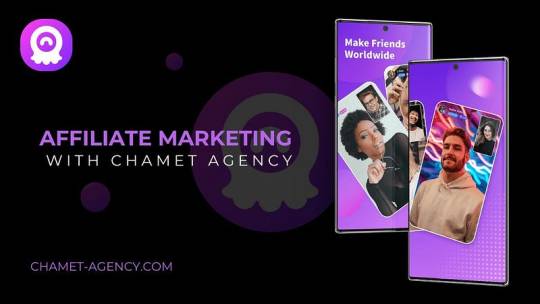
How to Use Affiliate Marketing to Grow Your Chamet Agency
Affiliate marketing is one of the most effective strategies to expand your Chamet agency. By leveraging this powerful digital marketing method, you can recruit more hostesses, attract subagents, and grow your network while maximizing your earnings.
This guide will walk you through how to use affiliate marketing to grow your Chamet agency successfully.
What Is Affiliate Marketing?
Affiliate marketing involves promoting a product or service and earning a commission for every successful referral. For Chamet agents, affiliate marketing focuses on sharing your agency’s unique invitation links to recruit:
Hostesses: Individuals who can earn by live streaming, engaging with viewers, and receiving gifts.
Subagents: People who build their own Chamet agency networks under your mentorship.
By using affiliate marketing tactics, you can efficiently attract recruits, expand your agency, and boost your revenue.
Why Affiliate Marketing Works for Chamet Agents
Affiliate marketing is highly effective for Chamet agents for several reasons:
Cost-Effective: You don’t need a large budget to start; social media and online platforms are often free to use.
Wide Reach: You can target a global audience using platforms like Facebook, Instagram, and TikTok.
Scalability: Once your content or campaigns are set up, they can attract recruits on autopilot.
Measurable Results: Chamet’s invitation links allow you to track your recruitment performance easily.
How to Use Affiliate Marketing for Your Chamet Agency
1. Promote Your Unique Invitation Links
Chamet provides agents with personalized links for recruiting hostesses and subagents. Share these links to direct potential recruits to the registration page. Here’s how:
Post your link on social media bios, posts, and stories.
Share it in email newsletters targeted at potential hostesses and subagents.
Include it in blog articles or YouTube videos about becoming a Chamet hostess or agent.
2. Identify Your Target Audience
Focus on reaching people who are most likely to succeed as hostesses or subagents. These include:
Aspiring Hostesses: Women aged 18–35 who are comfortable on camera and want flexible earning opportunities.
Potential Subagents: Individuals with experience in network marketing, sales, or management who are motivated to build their own teams.
Tailor your messaging to address the specific needs and motivations of each group.
3. Use Social Media to Your Advantage
Social media is one of the best tools for affiliate marketing. Use platforms like Instagram, Facebook, TikTok, and LinkedIn to:
Create Engaging Content: Share success stories, tips for earning on Chamet, and testimonials from your hostesses or subagents.
Use Video Marketing: Videos tend to get higher engagement. Post short clips explaining Chamet’s benefits or showcasing your team’s achievements.
Run Paid Ads: Boost your reach by running targeted ads on platforms like Facebook or Instagram. Use keywords like “earn from live streaming” or “work from home” to attract potential recruits.
4. Create Valuable Content
Position yourself as a trusted expert by sharing helpful content related to Chamet:
Write blog posts about the benefits of becoming a Chamet hostess or agent.
Record YouTube videos explaining how Chamet works and how much people can earn.
Post tutorials on optimizing live streams or earning more on Chamet.
5. Leverage Email Marketing
Email marketing is an excellent way to nurture leads and keep potential recruits engaged. Build an email list and send:
Updates about Chamet opportunities.
Tips for succeeding as a hostess or subagent.
Testimonials and case studies from successful members of your team.
6. Collaborate with Influencers
Partnering with influencers who align with your target audience can help you reach more people. Influencers can:
Share your invitation link with their followers.
Create content about joining your Chamet agency.
Host live Q&A sessions to address potential recruits’ questions.
7. Track Your Performance
Chamet’s tools allow you to monitor the performance of your affiliate marketing campaigns. Use your agent dashboard to track:
The number of recruits who registered using your invitation link.
The activity levels and earnings of your hostesses and subagents.
The overall growth of your agency.
Analyzing these metrics helps you refine your strategies and focus on what works best.
Tips for Success in Affiliate Marketing
1. Be Authentic Authenticity builds trust. Share genuine experiences, testimonials, and results from your Chamet journey to inspire confidence in potential recruits.
2. Highlight Chamet’s Benefits Focus on Chamet’s key selling points, such as:
Unlimited earning potential.
Flexible work schedules.
Daily payouts.
Tools and support for success.
3. Stay Consistent Consistency is key to building momentum. Post regularly, engage with your audience, and keep refining your approach.
4. Use Visuals Eye-catching images and videos attract more attention than plain text. Use high-quality visuals in your content to make it more appealing.
Why Affiliate Marketing Is Essential for Chamet Agents

Ready to grow your Chamet agency? Visit the Chamet Agency Registration Page and start expanding your network today.
3 notes
·
View notes
Text
ideas about digital marketing

Leverage User-Generated Content (UGC)
Encourage customers to share photos, videos, or reviews of your product/service.- Create a branded hashtag and run contests or campaigns around it.- Feature UGC on your website, social media, or email campaigns to build trust and authenticity.---2. Create Interactive Content
Develop quizzes, polls, or surveys to engage your audience.- Use tools like Typeform or Outgrow to create interactive experiences.- Example: A skincare brand could create a "What’s Your Skin Type?" quiz.---
-3. Host Webinars or Live Streams
Share valuable insights, tutorials, or Q&A sessions related to your industry.- Promote the event on social media and email lists.- Repurpose the recording into blog posts, YouTube videos, or social media
-4. Collaborate with Influencers
Partner with micro-influencers (10k–100k followers) for authentic promotion.- Run giveaways or sponsored posts with influencers in your niche.- Focus on long-term partnerships for better ROI.---5. Optimize for Voice Search
Create content that answers conversational questions (e.g., "What’s the best [product] for [problem]?").- Use long-tail keywords and natural language in your SEO strategy.- Optimize for local search with phrases like "near me.
#onlinebusiness#passive income#work from home#make money online#earn money online#digital marketing#financialfreedom#affiliatemarketing#money
2 notes
·
View notes
Text
What Are the Key Strategies for App Marketing

In an era where mobile applications are a vital part of everyday life, simply developing an app isn’t enough. To ensure that your app stands out in the crowded market, a comprehensive and well-executed marketing strategy is essential. Effective app marketing not only helps in attracting new users but also in retaining them, driving engagement, and generating revenue. Below, we delve into the key strategies for successful app marketing that can help your app achieve its full potential.
1. App Store Optimization (ASO)
The practice of making your app's listing more visible and converts more frequently in app stores like Google Play and the Apple App Store is called App Store Optimisation, or ASO. Similar to SEO for webpages, ASO is for applications. This is how ASO can be implemented successfully: The main goal of content marketing is to draw in and keep your target audience by producing and sharing good, timely information.Here's how to put an effective email marketing plan into practice:Send emails that are tailored to the interests of each section.
Keyword Optimization: Start by researching relevant keywords that your target audience is likely to use when searching for an app like yours. Incorporate these keywords into your app’s title, description, and tags to improve discoverability.
Compelling Title and Description: Your app’s title should be catchy, memorable, and include your primary keyword. The description should clearly communicate what your app does, highlighting its unique value propositions. Remember, the first few lines of your description are crucial as they appear before the “Read More” prompt.
High-Quality Visuals: Use attractive screenshots and an engaging app preview video to showcase your app’s features. Visuals play a significant role in converting app store visitors into users.
Positive Reviews and Ratings: Encourage satisfied users to leave positive reviews and ratings. High ratings and positive feedback improve your app’s ranking in search results and increase its credibility.
2. Leverage Social Media Marketing
Social media platforms offer a powerful way to promote your app, engage with users, and build a community around your brand. Here’s how to leverage social media for app marketing:
Targeted Advertising: Platforms like Facebook, Instagram, and Twitter allow you to run highly targeted ad campaigns. You can target users based on demographics, interests, and behaviors that align with your app’s niche, increasing the chances of conversions.
Engaging Content: Create and share content that resonates with your target audience. This could include app usage tips, updates, user testimonials, and behind-the-scenes content. Engaging content helps to build a loyal following and keeps your app top-of-mind.
Influencer Collaborations: Partnering with influencers who have a strong following in your app’s target market can significantly boost your app’s visibility and downloads. Influencers can showcase your app’s features and endorse it to their audience, lending credibility and trust to your brand.
3. Content Marketing
Content marketing is all about creating and distributing valuable, relevant content to attract and engage your target audience. For app marketing, consider the following content strategies:
Blog Posts: Write informative blog posts related to the problems your app solves. These posts should provide valuable insights and naturally integrate your app as the solution. For example, if your app is a fitness tracker, blog about fitness tips, workouts, and how your app can help users achieve their fitness goals.
Tutorials and How-To Guides: Create detailed tutorials and how-to guides that demonstrate how to use your app. These can be in the form of blog posts, videos, or infographics. Educating your audience on how to get the most out of your app can increase user satisfaction and retention.
Guest Blogging: Contribute guest posts to popular blogs in your industry. This not only builds backlinks to your app’s website but also introduces your app to a broader audience. Ensure that your guest posts are informative and provide genuine value to readers.
4. Email Marketing
Email marketing is a direct and effective way to engage with both potential and existing users. Here’s how to implement a successful email marketing strategy:
Personalized Campaigns: Segment your email list based on user behavior, preferences, and demographics. Send personalized emails that cater to each segment’s interests. For instance, new users might receive a welcome email series, while existing users could receive tips on advanced features.
Re-Engagement Emails: For users who have become inactive, send re-engagement emails offering incentives to return. These could be in the form of discounts, new features, or personalized recommendations.
Regular Newsletters: Keep your users informed with regular newsletters. Share updates about new features, upcoming events, and other relevant news. A well-crafted newsletter can keep your app at the forefront of users’ minds.
5. Paid Advertising
Paid advertising can give your app the visibility boost it needs, especially in the initial stages. Here’s how to approach paid advertising:
Google Ads and Apple Search Ads: Use search ads to target users searching for apps similar to yours. These ads appear at the top of search results, increasing your app’s visibility to potential users.
Social Media Ads: Social media platforms offer a variety of ad formats, including image ads, video ads, carousel ads, and stories ads. Experiment with different formats to see what resonates best with your audience.
Retargeting Ads: Retarget users who have shown interest in your app but haven’t downloaded it yet. Retargeting ads remind these users of your app and encourage them to take the final step.
6. App Reviews and Ratings
Managing your app’s reviews and ratings is crucial for maintaining a positive image and improving visibility. Here’s how to handle this aspect:
Encouraging Positive Reviews: Prompt users to leave reviews after they’ve had a positive experience with your app. You can do this through in-app prompts or follow-up emails. Make it easy for users to leave a review with just a few clicks.
Responding to Reviews: Engage with users by responding to their reviews, both positive and negative. Thank users for their positive feedback and address any concerns raised in negative reviews. This shows that you value user feedback and are committed to improving your app.
Monitoring Competitors: Keep an eye on your competitors’ reviews to see what users like or dislike about their apps. Use this information to make improvements to your own app and stay ahead in the market.
7. Referral Programs
Referral programs can be a highly effective way to grow your app’s user base. Encourage your existing users to refer your app to others by offering incentives:
In-App Rewards: Offer in-app rewards such as discounts, free features, or credits to users who successfully refer new users to your app.
Social Sharing: Make it easy for users to share your app with their social networks. Include social sharing buttons within your app and incentivize sharing with rewards or exclusive content.
Conclusion
The success of your mobile app largely depends on how well you market it. By implementing these key strategies—App Store Optimization, social media marketing, content marketing, email marketing, paid advertising, managing reviews and ratings, and referral programs—you can ensure that your app not only reaches a broad audience but also retains and engages users effectively.
For more comprehensive support in your app marketing efforts, explore our Mobile Application Marketing services or get in touch with our Digital Marketing services company to help you achieve your app’s full potential.
#Mobile Application Marketing#Digital Marketing services company#Mobile Application Marketing services#Digital Marketing company
3 notes
·
View notes
Text
Unlock Your Marketing Potential: Powerful Tips for an Effective Content Strategy
At Imagency Media, we understand that a well-crafted content strategy can be the key to unlocking your brand’s full marketing potential. In today’s competitive landscape, simply creating content isn’t enough—you need a strategic approach that aligns with your business goals and resonates with your target audience. Here are some powerful tips and guidelines to help you craft a content marketing strategy that delivers real results.

1. Document Your Strategy for Success
The foundation of any effective content strategy starts with clear documentation. Without a documented plan, your efforts can easily become disjointed and less effective
.

Set Clear Objectives: Define your content marketing goals. Are you looking to increase brand awareness, generate leads, or establish thought leadership? Your goals will guide your strategy.
Understand Your Audience: Develop detailed buyer personas to gain insights into your target audience’s needs, preferences, and pain points.
Map Out Content Types: Choose the types of content (blogs, videos, infographics) that align with your goals and audience preferences. For instance, if you’re targeting tech-savvy entrepreneurs, consider creating in-depth whitepapers and how-to guides.
Create a Content Calendar: Plan your content schedule in advance to ensure consistent delivery. This not only keeps your audience engaged but also helps you stay organized.
2. Amplify Engagement with Video Content
Video content is a powerhouse when it comes to capturing attention and driving engagement. Here’s how you can incorporate it into your strategy:
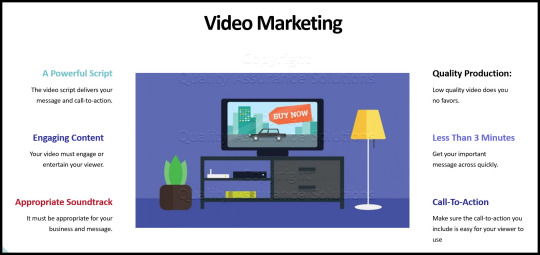
Explainer Videos: Simplify complex concepts with explainer videos. For example, a short video on how your branding services can transform a business can be more engaging than a lengthy article.
Customer Success Stories: Showcase real client testimonials in video format to build credibility and trust. Hearing positive experiences directly from satisfied clients can be a powerful motivator for potential customers.
Educational Tutorials: Offer value through educational videos or webinars. Whether it’s a tutorial on the latest design trends or a deep dive into the benefits of a strong brand identity, educating your audience builds trust and positions your brand as an authority.
Share on Social Platforms: Leverage platforms like YouTube, Instagram, and LinkedIn to share your video content and reach a wider audience.
3. Build Lasting Connections with an Email Strategy
Email marketing remains one of the most effective channels for nurturing leads and driving conversions. Here’s how to make the most of it:

Segment Your Audience: Personalize your emails by segmenting your list based on demographics, behavior, or interests. This ensures that your messages are relevant and timely.
Send Value-Packed Newsletters: Keep your subscribers engaged with regular newsletters. Include tips, industry news, and links to your latest blog posts or case studies. Don’t forget to add a compelling call-to-action to drive further engagement.
Automate Lead Nurturing: Set up automated email sequences to guide leads through the sales funnel. For instance, after a lead downloads a resource, follow up with a series of emails that provide additional insights and highlight your services.
Analyze and Optimize: Continuously monitor your email performance. Track open rates, click-through rates, and conversions to identify what works and what doesn’t. Use this data to refine your approach.
4. Educate Your Audience to Establish Authority
Educating your audience not only builds trust but also positions your brand as an expert in your field.
Create Insightful Blog Content: Regularly publish blog posts that address your audience’s pain points and offer solutions. For example, a post titled "5 Branding Mistakes to Avoid" can attract business owners looking to strengthen their brand.
Develop Comprehensive Resources: E-books, whitepapers, and guides provide in-depth information that your audience can refer to over time. Offering these resources in exchange for contact information also helps you generate leads.
Host Workshops and Webinars: Interactive sessions, whether in-person or online, allow you to engage with your audience in real-time. A webinar on "Effective UI/UX Design Practices" can attract those interested in improving their digital presence.
Share Quick Tips on Social Media: Regularly post bite-sized tips and insights on platforms like LinkedIn and Twitter. This not only keeps your audience engaged but also drives traffic to your website.
5. Boost Reach with Paid Promotion
While organic content is crucial, paid promotion can significantly expand your reach and accelerate your results.

Utilize Social Media Ads: Platforms like Facebook, Instagram, and LinkedIn offer highly targeted ad options. Promote your most valuable content, such as videos or in-depth articles, to specific audience segments.
Invest in Google Ads: Google’s search and display ads can help you reach potential clients actively searching for services like yours. Use retargeting ads to bring back visitors who have shown interest but haven’t yet converted.
Explore Sponsored Content: Partner with industry influencers or authoritative blogs to publish sponsored posts. This can increase your credibility and expose your brand to new audiences.
6. Measure, Optimize, and Re-assess for Continuous Improvement
No strategy is complete without regular evaluation and optimization. Here’s how to keep your content marketing efforts on track:
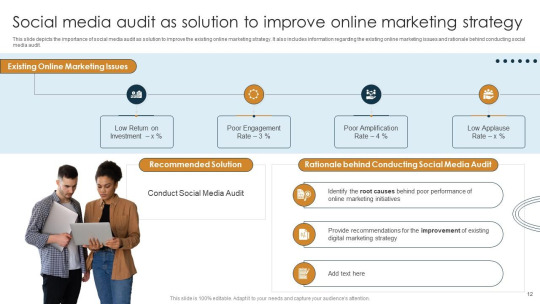
Track Key Metrics: Identify the KPIs that matter most to your business, such as website traffic, lead generation, conversion rates, and social media engagement.
Use Analytics Tools: Leverage tools like Google Analytics, HubSpot, and social media analytics to monitor your content’s performance. Look for patterns and insights that can guide your strategy adjustments.
Conduct Quarterly Reviews: Schedule regular reviews to assess your strategy’s effectiveness. Identify what’s working well and what needs adjustment. For example, if video content is driving high engagement, consider increasing your investment in video production.
Stay Agile: Content marketing is dynamic, so be prepared to adjust your strategy as needed. Stay informed about industry trends and be ready to pivot to new tactics that can drive better results.
Conclusion: Maximize Your Marketing Success with a Strategic Approach
By implementing these content marketing tips and guidelines, you can create a powerful strategy that not only attracts but also engages and converts your target audience. At Imagency Media, we’re committed to helping you elevate your brand through strategic content that delivers measurable results. With the right approach, your content can become a driving force behind your marketing success. Contact us and visit Imagency media to get more tips .
#digital marketing#social media marketing#digital services#marketing#google ads#branding#content marketing#content creation
2 notes
·
View notes
Text
Unveiling Effective Digital Marketing Strategies: A Comprehensive Guide
Introduction:
In today's fast-paced digital era, businesses constantly seek innovative ways to engage their target audience. With a plethora of digital marketing strategies available, navigating this landscape can be daunting. However, understanding and implementing the most effective tactics can unlock new opportunities for growth and success.
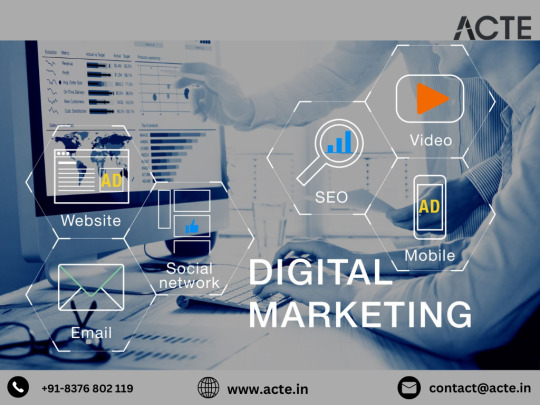
This comprehensive guide explores ten powerful digital marketing strategies and how they can be utilized to achieve your business objectives.
Chapter 1: Search Engine Optimization (SEO)
Search Engine Optimization (SEO) is fundamental to any successful digital marketing strategy. It involves optimizing your website to improve visibility in search engine results pages (SERPs) and attract organic traffic. Through keyword research, on-page optimization, technical SEO, and link building, a well-executed SEO strategy can enhance online presence, increase brand visibility, and drive targeted traffic.
Chapter 2: Content Marketing
Content marketing revolves around creating and distributing valuable, relevant content to engage your target audience. This includes blog posts, articles, videos, infographics, and more. By providing informative and entertaining content, you can build trust, establish authority, and drive organic traffic to your website, while also supporting other digital marketing efforts such as SEO and social media.
Chapter 3: Social Media Marketing
Social media platforms like Facebook, Instagram, Twitter, LinkedIn, and Pinterest offer powerful tools for connecting with your audience. Social media marketing involves creating compelling content, running targeted ads, and engaging with followers to increase brand awareness, drive website traffic, and generate leads. A well-planned social media strategy can foster a loyal community, nurture relationships, and drive conversions.
Chapter 4: Email Marketing
Email marketing remains one of the most effective ways to nurture leads and drive conversions. By building an email list and sending targeted, personalized emails, you can deliver relevant content, nurture leads through the sales funnel, and encourage action. With segmentation, automation, and personalization, email marketing enables delivering the right message to the right person at the right time.
Chapter 5: Pay-Per-Click (PPC) Advertising
Pay-Per-Click (PPC) advertising allows bidding for ad placement in search engine results or on other websites. Platforms like Google Ads and Bing Ads offer robust targeting options, enabling reaching your ideal audience based on keywords, demographics, and interests. PPC advertising drives targeted traffic to your website and generates leads or sales, with payment only upon ad clicks.

Chapter 6: Influencer Marketing
Influencer marketing involves collaborating with influential individuals on social media to promote products or services. By leveraging influencers' reach and credibility, you can reach a larger audience, build trust, and drive conversions. Authentic influencer partnerships create engaging content that resonates with your audience, increasing brand awareness and driving sales.
Chapter 7: Video Marketing
Video content continues to rise in popularity, offering a powerful marketing tool. Whether tutorials, product demos, or testimonials, video connects with your audience on a deeper level and drives engagement. Platforms like YouTube, TikTok, and Instagram provide opportunities to reach a vast audience with compelling video content, boosting brand visibility and website traffic.
Chapter 8: Affiliate Marketing
Affiliate marketing involves partnering with affiliates to promote your products or services in exchange for a commission on sales. Leveraging affiliates' reach and influence, you can increase brand exposure, drive traffic, and generate sales without upfront costs. Scalable and cost-effective, affiliate marketing expands reach and grows your business.
Chapter 9: Mobile Marketing
Optimizing digital marketing efforts for mobile devices is crucial with the rise of smartphones and tablets. Ensuring a mobile-friendly website, creating mobile-optimized content, and leveraging mobile-specific channels like SMS marketing reach consumers on the go. Mobile marketing delivers targeted messages, driving engagement and conversions.
Chapter 10: Remarketing
Remarketing targets users who have previously interacted with your brand but not converted. Serving targeted ads to these users encourages them to complete their purchase, maximizing ROI. Remarketing re-engages potential customers, drives conversions, and boosts the effectiveness of digital marketing efforts.
Conclusion:
Mastering digital marketing involves understanding various strategies and tactics and applying them effectively to achieve business goals. By leveraging SEO, content marketing, social media, email marketing, PPC advertising, influencer marketing, video marketing, affiliate marketing, mobile marketing, and remarketing, you can create a comprehensive strategy that drives results. With the right approach, digital marketing increases brand awareness, drives traffic, generates leads, and fuels business growth in today's competitive digital landscape.
#training#digital marketing#digital marketing course#email marketing#online marketing#search engine optimization#seo#digital marketing company#seo services#tech
3 notes
·
View notes
Text
What is Digital marketing and how can we earn from it?
According to me I can offer valuable insights into the field and lucrative earning opportunities. Digital marketing involves promoting products, services, or brands through various online channels, including websites, social media, search engines, email, and mobile apps. Here are some strategies and examples that are working well for freelancers in the digital marketing industry:
Content Creation and Marketing: Content remains king in digital marketing, and freelancers can capitalize on this by offering content creation services such as blog writing, article writing, video production, and infographic design. High-quality, engaging content helps businesses attract and retain customers while improving their search engine rankings.
Example: A freelance writer specializing in technology creates informative blog posts and whitepapers for software companies, helping them establish thought leadership in their industry and drive organic traffic to their website.
Search Engine Optimization (SEO): SEO is essential for businesses to improve their visibility in search engine results pages (SERPs) and drive organic traffic to their websites. Freelancers can offer SEO services such as keyword research, on-page optimization, link building, and SEO audits to help clients rank higher in search engine rankings.
Example: An SEO specialist helps a local bakery optimize its website for relevant keywords such as "best cakes in [city]," resulting in increased online visibility and more foot traffic to the bakery.
Social Media Management: Many businesses struggle to effectively manage their social media presence. Freelancers can offer social media management services, including content creation, posting schedules, community engagement, and paid advertising campaigns, to help clients grow their social media following and drive engagement.
Example: A freelance social media manager helps a small business owner create and curate engaging content for their Instagram account, increasing brand awareness and attracting new customers.
Email Marketing: Email marketing remains one of the most effective ways to nurture leads, promote products or services, and maintain customer relationships. Freelancers can offer email marketing services such as email campaign creation, list segmentation, A/B testing, and performance tracking to help clients generate leads and drive sales.
Example: An email marketing freelancer designs and implements a series of automated email campaigns for an e-commerce retailer, resulting in higher open rates, click-through rates, and conversions.
Pay-Per-Click (PPC) Advertising: PPC advertising allows businesses to reach their target audience through targeted ads on search engines and social media platforms. Freelancers can offer PPC management services, including keyword research, ad creation, bid management, and performance tracking, to help clients maximize their return on investment (ROI) from PPC campaigns.
Example: A freelance PPC specialist helps a startup company launch and optimize Google Ads campaigns, driving qualified traffic to their website and increasing sales leads.
Affiliate Marketing: Freelancers can participate in affiliate marketing programs to earn commissions by promoting products or services through their website, blog, or social media channels. By partnering with companies as affiliates, freelancers can monetize their online presence and audience.
Example: A freelance blogger writes product reviews and tutorials on their website and includes affiliate links to recommended products, earning commissions for every sale generated through their affiliate links.
Ready to take your digital marketing skills to the next level? Enroll now in our comprehensive free online masterclass and unlock the secrets to success in the ever-evolving world of digital marketing.
#digital marketing#masterclass#learn#online earning#affliate#freelance#career#career in digital marketing
2 notes
·
View notes
Text
A Simple Method for Affiliate Marketing that Doesn’t Require a Website
Affiliate marketing has grown in popularity in recent years as a viable way to make passive income. When it comes to promoting items and collecting money, many affiliate marketers have traditionally relied on websites. However, not everyone can afford or has the time to learn how to build and manage their own website. Thankfully, affiliate marketing can be done in a straightforward manner that doesn’t require the creation of a website. For a fresh start in affiliate marketing, consider this alternate method, which we shall explore in more detail below.
My Best Recommended & Proven Way to Make $100 Daily — Watch THIS FREE Training to START >>

What is Affiliate Marketing?
Before we dive into the no-website method, let’s briefly understand what affiliate marketing is. Affiliate marketing is a performance-based marketing strategy where individuals or affiliates promote products or services of a company. In return, they earn a commission for every sale, click, or action generated through their marketing efforts. Typically, affiliates use websites, blogs, or social media to promote affiliate products, but there’s a different route to explore.
Affiliate Marketing Without a Website
Affiliate Marketing Without a Website provides a viable path for people to join the world of affiliate marketing without the necessity for website creation expertise. Affiliate marketers may promote items and earn commissions without a website by leveraging the popularity of social media, email marketing, and video content development. This strategy emphasises accessibility and streamlines the entrance procedure into the affiliate marketing sector.
Leveraging Social Media Platforms
One of the most accessible ways to engage in affiliate marketing without a website is by utilizing social media platforms such as Facebook, Instagram, and Twitter. Here’s how you can get started:
Creating Engaging Content
To succeed on social media, you need to create content that resonates with your audience. This can include informative posts, captivating images, and engaging videos. Your content should provide value and capture the attention of your followers.
Building a Following
Building a substantial following on social media takes time and effort. Interact with your audience, respond to comments, and engage in conversations related to your niche. Over time, your follower count will grow, increasing your reach as an affiliate marketer.
Email Marketing as an Affiliate Tool
Email marketing is another powerful method for affiliate marketing without a website. Here’s how you can make it work for you:
Building an Email List
Start by building an email list of subscribers interested in your niche. Offer valuable content or incentives in exchange for their email addresses. This list becomes your direct channel to promote affiliate products.
Crafting Persuasive Emails
Crafting persuasive emails is crucial. Share your personal experiences with the products you’re promoting, highlight their benefits, and include compelling calls to action with your affiliate links.
YouTube and Video Marketing
YouTube provides an excellent platform for affiliate marketing through video content. Here’s how to leverage it effectively:
Creating Informative Videos
Create videos that educate your audience about the products or services you’re promoting. Offer in-depth reviews, demonstrations, and tutorials. Include affiliate links in your video descriptions for interested viewers to click.
My Best Recommended & Proven Way to Make $100 Daily — Watch THIS FREE Training to START >>
Choosing the Right Affiliate Products
Choosing the Right Affiliate Products is pivotal for affiliate marketers. Identifying a compatible niche, researching profitable products, and evaluating affiliate programs ensure that the products align with the audience’s needs and preferences, enhancing the chances of successful promotions and commissions, it’s essential to choose the right products to promote:
Identifying Your Niche
Identify a niche that aligns with your interests and expertise. This will make your marketing efforts more authentic and engaging.
Researching Profitable Products
Research and select affiliate products that have a proven track record of sales and positive reviews. Look for products that genuinely provide value to your target audience.
Evaluating Affiliate Programs
Join reputable affiliate programs that offer fair commissions, reliable tracking, and support for their affiliates. Avoid programs with a history of payment issues or unethical practices.
Content Creation for Affiliate Success
Creating high-quality content is the cornerstone of affiliate marketing success:
Understanding Your Target Audience
Get to know your target audience’s needs, pain points, and preferences. Tailor your content to address their specific interests.
Crafting Compelling Product Reviews
Write or create in-depth product reviews that highlight the features and benefits of the affiliate products. Be honest and transparent in your assessments.
Demonstrating Product Benefits
Showcase how the affiliate products can solve problems or improve the lives of your audience. Use real-life examples and scenarios to illustrate their value.
Storytelling for Emotional Engagement
Share personal stories and anecdotes related to the affiliate products. Storytelling creates emotional connections with your audience, making them more likely to trust your recommendations.
Tracking and Analytics
TTracking and analytics are key to affiliate marketing success. By using affiliate monitoring tools, marketers can keep tabs on how well their efforts are doing in terms of clicks, conversions, and revenue. Affiliate marketers may improve their efficacy in pushing items and earning commissions by analysing the aforementioned data points and acting accordingly, you’ll need to track and analyze your performance:
Utilizing Affiliate Tracking Tools
Use affiliate tracking tools provided by affiliate programs to monitor clicks, conversions, and commissions. This data helps you understand what’s working and what needs improvement.
Analyzing Campaign Performance
Regularly review your campaigns’ performance metrics. Identify which products and strategies are generating the best results and focus your efforts accordingly.
Making Data-Driven Improvements
Use the insights gained from tracking and analytics to make data-driven improvements to your affiliate marketing efforts. Experiment with different approaches to optimize your results.
Legal and Ethical Considerations
Success in affiliate marketing relies heavily on tracking and analytics. A marketer’s success in generating clicks, conversions, and income may be tracked in real time with the help of affiliate monitoring tools. By assessing and acting on the aforementioned data points, affiliate marketers may increase their efficiency in pushing products and collecting rewards, it’s essential to be aware of legal and ethical considerations:
Disclosure of Affiliate Relationships
Always disclose your affiliate relationships to your audience. Transparency builds trust, and it’s a legal requirement in many jurisdictions, including the United States.
Compliance with FTC Guidelines
Familiarize yourself with the Federal Trade Commission (FTC) guidelines for affiliate marketing. Ensure that your promotional content complies with these regulations.
Maintaining Trust with Your Audience
Maintaining trust with your audience is paramount. Only promote products that you genuinely believe in and that provide value to your audience. Avoid promoting low-quality or scammy products.
My Best Recommended & Proven Way to Make $100 Daily — Watch THIS FREE Training to START >>
Case Studies and Success Stories
In the world of affiliate marketing, case studies and success stories are gold mines of information. Successful affiliate marketers can teach us a lot about what works and what doesn’t by sharing their stories and the lessons they’ve learned along the way. These accounts provide as motivation and direction for prospective affiliates, empowering them to make smart choices and successfully negotiate the affiliate marketing marketplace:
Real-Life Examples of Successful Affiliate Marketers
Share case studies and success stories of affiliate marketers who have achieved significant success without a website. Highlight their strategies, challenges, and key takeaways.
Learning from their strategies and experiences
Learning from strategies and experiences of successful affiliate marketers offers valuable insights and actionable tips, helping others replicate their success in the industry effectively.
Challenges and How to Overcome Them
A crucial component of affiliate marketing is challenges and how to overcome them. While responding to competition entails developing original material, responding to changes in affiliate programmes necessitates remaining informed and modifying techniques. By prioritising self-care, taking pauses, and establishing reasonable objectives, one may avoid burnout while achieving long-term success in the cutthroat affiliate marketing sector:
Dealing with Competition
Competitive niches can be challenging to break into. Focus on creating unique and valuable content that sets you apart from the competition.
Handling Affiliate Program Changes
Affiliate programs may change their terms or commission rates. Stay informed and adapt your strategy accordingly to mitigate the impact of such changes.
Avoiding Burnout
Consistency is essential in affiliate marketing, but it’s also important to avoid burnout. Set realistic goals, take breaks, and prioritize self-care.
Conclusion
In conclusion, affiliate marketing without a website is not only possible but also a viable option for those who want to enter the affiliate marketing arena without the hassle of website creation and maintenance. By leveraging social media platforms, email marketing, and influencer collaborations, you can effectively promote affiliate products and earn commissions. Remember that consistency, authenticity, and providing value to your audience are key to success in this affiliate marketing journey. So, start implementing these strategies, and you’ll be on your way to becoming a successful affiliate marketer, even without a website!
Unique FAQs
What exactly is affiliate marketing?
Affiliate marketing is a performance-based marketing strategy where individuals promote products or services on behalf of a company and earn a commission for each sale or action generated through their marketing efforts.
2. Is affiliate marketing legal?
Yes, affiliate marketing is legal, but it’s important to comply with relevant laws and regulations, including disclosing your affiliate relationships and adhering to the Federal Trade Commission (FTC) guidelines.
3. Can anyone become an affiliate marketer without a website?
Yes, anyone can become an affiliate marketer without a website by using social media, email marketing, video content, and other platforms to promote affiliate products.
4. How long does it take to see results in affiliate marketing without a website?
The timeline for seeing results in affiliate marketing varies depending on factors such as your niche, marketing strategy, and audience engagement. It may take several months to start seeing significant income.
5. What are some effective ways to promote affiliate products on social media?
Effective ways to promote affiliate products on social media include creating engaging content, building a following, and being transparent about your affiliate relationships. Additionally, using storytelling and personal experiences can be compelling strategies.
My Best Recommended & Proven Way to Make $100 Daily — Watch THIS FREE Training to START >>
Affiliate Disclaimer :
This article Contain may be affiliate links, which means I receive a small commission at NO ADDITIONAL cost to you if you decide to purchase something. While we receive affiliate compensation for reviews / promotions on this article, we always offer honest opinions, users experiences and real views related to the product or service itself. Our goal is to help readers make the best purchasing decisions, however, the testimonies and opinions expressed are ours only. As always you should do your own thoughts to verify any claims, results and stats before making any kind of purchase. Clicking links or purchasing products recommended in this article may generate income for this product from affiliate commissions and you should assume we are compensated for any purchases you make. We review products and services you might find interesting. If you purchase them, we might get a share of the commission from the sale from our partners. This does not drive our decision as to whether or not a product is featured or recommended.
Source : A Simple Method for Affiliate Marketing that Doesn’t Require a Website
Thanks for reading my article on “How I Made $103 Just Two Days with CPA Marketing for a Beginner“, hope it will help!
#howtomakemoneyonline#makemoneyonline#makemoneyonline2023#makemoneyonlinefromhome#makemoneyfast#affiliatemarketing#cpamarketing#blogging#dropshipping#ecommerce#passiveincome#makemoneytutorials#methodsandtutorials#internetmarketing#digitalmarketing#clickbankaffiliatemarketing#affiliatemarketingtraining#cpamarketingtraining#cpa#blog#makemoney#makemoneyonlineguide#freelancingtraining#emailmarketing#makemoneyonlinewithblogging#amazonaffiliatemarketing#marketingstrategies#onlineadvertising#socialmediamarketing#contentmarketing
6 notes
·
View notes
Text
Top 10 Shopify Marketing Strategies to Skyrocket Your Sales in 2025"
Shopify is a effective e-trade platform that empowers corporations of all sizes to construct on line shops. However, simply having a shop isn't sufficient; effective advertising is important to attract clients and power sales. This manual will discover key Shopify advertising techniques and strategies that will help you prevail.

"Effective Shopify store promotion methods in 2025"
1. Content Marketing
Blog: Create valuable content that addresses your audience's pain factors, answers their questions, and presents beneficial records.
Examples: Product courses, industry news, behind-the-scenes glimpses, consumer testimonials.
Social Media: Engage together with your target audience on platforms like Instagram, Facebook, Twitter, and TikTok. Share visually attractive content material, run contests and giveaways, and respond right away to feedback and messages.
Video Marketing: Create engaging films like product demos, tutorials, and consumer testimonies. Platforms like YouTube and TikTok are exquisite for video advertising and marketing.
2. Search Engine Optimization (search engine marketing)
On-Page SEO: Optimize your product pages, weblog posts, and website copy with applicable keywords. Use clear and concise product descriptions, exceptional images, and rapid loading instances.
Off-Page search engine marketing: Build splendid one-way links from different authentic websites. Engage in guest blogging, take part in on-line groups, and build relationships with different groups.
Technical SEO: Ensure your internet site is cellular-pleasant, has a stable connection (HTTPS), and is simple for search engines to crawl and index.
Three. Email Marketing
Build an Email List: Offer incentives like discounts or one of a kind content to inspire site visitors to enroll in your e mail list.
Segment Your Audience: Tailor your e-mail campaigns to particular customer segments based on their purchase records, surfing behavior, and demographics.
Automate Your Emails: Use email advertising automation equipment to ship welcome emails, abandoned cart reminders, and post-buy comply with-up messages.
4. Paid Advertising
Google Ads: Run focused ads on Google Search and Google Display Network to attain clients actively searching for products like yours.
Social Media Ads: Utilize centered ads on structures like Facebook, Instagram, and Pinterest to reach specific demographics and hobbies.
Influencer Marketing: Partner with applicable influencers to promote your merchandise to their fans.
Five. Social Proof
Customer Reviews: Display patron opinions and testimonials prominently in your internet site and product pages.
Social Media Mentions: Encourage social media sharing by means of strolling contests and providing incentives.
User-Generated Content: Feature consumer-generated content like snap shots and videos of clients the usage of your merchandise.
6. Sales and Promotions
Discounts and Coupons: Offer discounts, coupons, and special promotions to draw new clients and incentivize repeat purchases.
Flash Sales: Create a sense of urgency via imparting confined-time discounts on choose merchandise.
Loyalty Programs: Reward repeat customers with unique discounts, early get right of entry to to income, and personalized offers.
7. Website Optimization
User Experience (UX): Ensure your internet site is straightforward to navigate, visually attractive, and cell-friendly.
Page Speed: Optimize your website's loading speed to enhance person experience and search engine ratings.
Clear Call-to-Actions (CTAs): Use strong CTAs like "Buy Now," "Add to Cart," and "Learn More" to manual site visitors towards conversions.
Eight. Customer Service
Provide Excellent Support: Offer activate and beneficial customer support via channels like live chat, e-mail, and phone.
Build Relationships: Go the extra mile to construct sturdy relationships along with your customers.
Address Feedback: Actively solicit and respond to client comments to improve your products and services.
Nine. Analytics and Tracking
Track Key Metrics: Monitor key metrics like internet site site visitors, conversion charges, client acquisition cost, and client lifetime fee.
Analyze Data: Use facts analytics tools to pick out areas for development and optimize your advertising campaigns.
A/B Testing: Experiment with exclusive website factors and advertising and marketing campaigns to peer what plays best.
10. Shopify Apps
Boost Sales: Utilize Shopify apps to beautify your advertising efforts, which include apps for e-mail advertising, social media advertising and marketing, and sales automation.
Improve Customer Experience: Implement apps that enhance customer experience, such as stay chat, product pointers, and transport monitoring.
Increase Efficiency: Streamline your commercial enterprise operations with apps for inventory management, order fulfillment, and accounting.
Key Considerations:
Target Audience: Understand your target market's wishes, choices, and on line conduct.
Budget: Determine your advertising budget and allocate finances efficiently throughout exceptional channels.
Consistency: Maintain regular branding and messaging across all advertising channels.
Innovation: Stay updated with the modern day advertising tendencies and technologies.
Shopify Marketing Examples:
Allbirds: Known for its sustainable footwear, Allbirds efficaciously leverages social media marketing, person-generated content, and influencer collaborations to build a sturdy emblem following.
Glossier: Glossier has built a devoted community thru social media engagement, actual logo storytelling, and a focus on purchaser experience.
Gymshark: Gymshark correctly makes use of influencer marketing, health demanding situations, and a strong social media presence to engage its target audience of fitness enthusiasts.
By imposing these techniques and strategies, you may efficiently marketplace your Shopify shop, appeal to clients, and force sales growth. Remember to constantly analyze your effects, adapt your technique based on statistics, and live focused on supplying value on your clients.
Disclaimer: This records is for general understanding and informational functions most effective and does now not constitute monetary, funding, or other professional advice.
I desire this comprehensive guide provides precious insights into Shopify advertising. Feel unfastened to invite if you have any further questions.
2 notes
·
View notes
Text

The Leading Ecommerce Site Daraz Has An Extraordinary Marketing Strategies...
Digital marketing is a crucial aspect of success for any e-commerce business, and Daraz, a leading e-commerce platform in South Asia, is no exception. To effectively reach its target audience and drive sales, Daraz employs a comprehensive digital marketing strategy that encompasses various channels and tactics. Here's a breakdown of Daraz's digital marketing approach:
1.Search Engine Optimization (SEO): Daraz prioritizes optimizing its website and product listings to rank high in search engine results pages (SERPs). This involves keyword research, content optimization, technical SEO, and backlink building. By improving its website's visibility in search results, Daraz attracts organic traffic from potential customers actively searching for products they offer.
2.Social Media Marketing (SMM): Daraz maintains a strong presence on various social media platforms, including Facebook, Instagram, and Twitter. Through engaging content, targeted ads, and influencer partnerships, Daraz builds brand awareness, interacts with customers, and drives traffic to its website. Social media serves as a powerful tool for generating leads, promoting new products, and fostering customer loyalty.
3.Pay-Per-Click (PPC) Advertising: Daraz utilizes PPC campaigns on search engines like Google and social media platforms to reach a wider audience and boost website traffic. PPC allows Daraz to display targeted ads to users based on their search queries and interests, increasing the likelihood of converting them into customers.
4.Content Marketing: Daraz creates and shares informative and engaging content, such as blog posts, product reviews, and video tutorials, to attract and educate potential customers. This content builds brand authority, establishes Daraz as a thought leader in the e-commerce industry, and encourages organic traffic to its website.
5.Email Marketing: Daraz nurtures relationships with existing customers through personalized email campaigns. These emails may include product recommendations, promotional offers, and abandoned cart reminders, encouraging customers to revisit the website and make purchases.
6.Affiliate Marketing: Daraz partners with bloggers, social media influencers, and other website owners to promote its products. These affiliates earn a commission for each sale generated through their unique referral links, incentivizing them to promote Daraz to their audience.
7.Mobile App Marketing: Daraz heavily promotes its mobile app, offering exclusive discounts and features to encourage users to download and use the app. The app provides a seamless shopping experience, facilitating impulse purchases and increasing customer engagement.
8.Performance Tracking and Analysis: Daraz continuously monitors and analyzes the performance of its digital marketing campaigns, using data-driven insights to optimize its strategies and maximize ROI. This data-driven approach ensures that Daraz allocates its resources effectively and focuses on the most impactful marketing channels.
In conclusion, Daraz's comprehensive digital marketing strategy, encompassing SEO, SMM, PPC, content marketing, email marketing, affiliate marketing, mobile app marketing, and performance tracking, enables the e-commerce giant to reach its target audience, drive traffic, increase sales, and build a loyal customer base.
3 notes
·
View notes
Text
Digital Marketing Courses That Actually Work: No BS, Just Real Skills

Are you sick of wasting time on YouTube tutorials that don’t get results?
Ever signed up for a digital marketing course that promised the world but left you confused and broke?
I’ve been there.
Most courses online are filled with theory. Buzzwords. and people who’ve never actually run ads.
That’s why I’m writing this. To help you find Digital Marketing Courses that actually work. Real skills. Real results. No fluff.
Let’s dive in.
What Makes a Digital Marketing Course Worth It?
A great course is simple. It teaches things you can use the same day. It doesn’t waste time. And it’s taught by someone who’s done it in real life.
Here’s what to look for:
Clear, step-by-step training
Real-world case studies
Assignments you’ll actually use
Support or mentorship
Updated content (nothing from 2012)
If a course is all theory and no application, skip it.
Why Digital Marketing Skills Matter in 2025
Look around. Everyone’s online. Every business wants traffic. They want leads. They want sales.
If you know how to drive traffic and convert it—you are valuable and important. Simple as that.
And with the rise of AI, knowing how to market is even more important.
Because tools are getting smarter. But strategy still wins.
That’s where Digital Marketing Courses come in. They give you the edge.
Common Pain Points People Face
Most people trying to learn marketing face these:
Too much info online
Not knowing where to start
Spending money on bad courses
Learning outdated methods
Sound familiar? That’s exactly why you need the right roadmap.
The Main Skills You’ll Learn
Let’s talk skills. Not jargon. Not buzzwords. Just straight-up value.
1. Paid Ads (Facebook, Google, Instagram)
How to:
Set up high-converting campaigns
Read data properly
Stop wasting ad spend
2. Organic Growth (Social Media + SEO)
You’ll learn:
What content actually works
How to rank on Google
The secret to long-term traffic
3. Email Marketing (And Why It Still Works)
Yes, email is still king. Even in 2025.
A good email marketing course teaches you:
How to build a list
Write emails that get clicks
Use automation without being spammy
You can check out our internal Email Marketing Courses too.
4. Funnels + Landing Pages
Want sales? You need funnels.
You’ll learn:
How to write pages that sell
The psychology behind clicks
Tools to build pages fast
5. Analytics + Testing
Guessing is dead. Data wins.
Here’s what the right course teaches:
Read Google Analytics
Split test like a pro
Make better decisions
6. SEO: Search Engine Optimisation
We’re talking about ranking without ads.
You’ll learn:
Keyword research
On-page + off-page SEO
Backlinks that work
Need more in-depth on that? Check our Search Engine Optimization Courses.
Career Boss Institute: We Keep It Real
At Career Boss Institute, we don’t play games. We give you digital marketing skills that get results.
No recycled info. No fluff. Just raw, proven frameworks.
Our trainers are in the field. Running ads. Scaling campaigns. And building funnels that print money.
We know what works. We teach what we use.
Real Results From Real Students
You don’t need to be a genius. You don’t need tech skills. You just need to commit.
We’ve helped:
Freelancers go from zero to booked out
Business owners scale traffic by 3x
Students land their first high-paying job
And these aren’t rare cases. They happen every week.
Why Most Courses Fail
Here’s the truth: Most courses suck.
They’re made by gurus who stopped doing marketing years ago. They overpromise. Then deliver recycled content.
You walk away with a certificate. But no skill.
That’s not how we roll at Career Boss Institute.
Who These Digital Marketing Courses Are For
Let’s be real. These aren’t for everyone.
But if you:
Want to switch careers
Run a business
Work in marketing
Or just want to make money online
Then these courses are for you.
We teach in plain English. No tech talk unless you ask for it. No BS. Just straight value.
Still Not Sure? Here’s a Roadmap
Not sure where to start? Here’s what we suggest:
Start with the basics:
Learn how ads work
Set up social profiles
Run your first campaign
Then level up:
Take an email marketing course
Start building your funnel
Learn SEO
Finally:
Get analytics down
Start testing like a pro
Simple. Step-by-step. No guesswork.
How Long Do You Need to Learn?
This isn’t school. No 4-year degree.
You can get results in 30–60 days. But you’ve got to do the work.
We’ve had students land clients in their second month. Others take longer. Totally depends on your speed.
Tools You’ll Learn Inside
We cover all the good stuff:
Meta Ads Manager
Google Ads
Mailchimp, ConvertKit, and Klaviyo
Canva + ChatGPT for creatives
Google Analytics
SEMrush + Ubersuggest
And we keep it updated. Every quarter. No outdated dashboards.
Lifetime Access? Yep.
Buy once. Access forever.
We don’t believe in making you pay again. You learn at your pace. Come back anytime.
Conclusion: Why Wait?
If you want to win online, you need real talent. Not just knowledge. Execution. That’s what Digital Marketing Courses from Career Boss Institute give you.
Straight to the point. Step-by-step training. And a support system built for action-takers. So, if you’re done wasting time and ready to learn what works— Check out our Digital Marketing Courses today.
0 notes
Text
Affiliate Marketing Hacks: Top Earners' Secret to Maxing Out Their Earnings
Affiliate marketing has rapidly grown into a multi-billion-dollar industry, attracting entrepreneurs, influencers, and bloggers from all over the world. But while many people try their hand at it, only a fraction become top earners. What separates the elite from the rest? The answer lies in smart strategies, data-driven decisions, and consistent optimisation. In this article, we’ll uncover the most powerful Affiliate Marketing Hacks that top performers use to maximise their income.
Learning the Fundamentals First
It is essential to learn the basics before jumping into Affiliate Marketing Hacks. Affiliate marketing entails the promotion of other individuals' products and earning commissions on each sale that is made through your referral link. It is a performance-based structure, and that means your income is directly linked to your efforts and strategies.
Top earners know the foundation matters: choosing the right niche, finding reliable affiliate programs, and building a strong content platform (blog, YouTube channel, or email list). These basics are non-negotiable for long-term success.
Hack #1: Choose High-Converting, High-Commission Products
One of the most important Affiliate Marketing Hacks is choosing the right products. Don't pursue high commissions alone — pay attention to conversion rates as well. A product paying 50% commission is pointless if nobody is buying it.
Top earners study affiliate dashboards and data analytics to see what's already selling. They tend to also test various offers in real-time with A/B testing to discover the commission rate vs. conversion potential sweet spot.
Tip: Hunt for evergreen products or subscription services. These can earn you recurring monthly commissions, enabling you to create passive income streams.
Hack #2: Build an Email List Early
One of the most effective affiliate marketing tools is an email list. Social media algorithms and SEO may shift overnight, but your email list belongs to you.
One of the most underrated Affiliate Marketing Hacks is beginning email capture from day one. Utilise lead magnets such as free eBooks, discount codes, or video series to get them onto your list. Once they're on your list, give them value regularly and intermingle your affiliate promotions in there strategically.
Successful producers use email automation tools such as ConvertKit, ActiveCampaign, or GetResponse to create automated funnels that nurture leads and turn them into buyers, even if they are sleeping.
Hack #3: Build Honest, Value-Driven Content
Shoppers are smarter than ever. They can smell a hard sell from a mile away. Successful affiliate marketers employ value-driven content to establish trust with their audience.
Think reviews, tutorials, comparisons, and case studies. These types of content not only attract traffic but also educate the user, getting them to buy via your affiliate link.
One of the best affiliate marketing hacks is storytelling. Don't give product features — share with your readers how it worked for you. Real-life experiences sell better than any sales pitch.
Hack #4: Use SEO and Content Clustering
Having organic, free traffic from search engines is a fantasy for all affiliate marketers. Super affiliates optimise their websites through SEO and content clustering.
Content clustering means having a pillar page (for example, "Ultimate Guide to Fitness Supplements") and linking it with associated articles (for example, "Best Pre-Workout Supplements," "Top Whey Proteins"). This informs Google about the topic context and ranks better.
When using Affiliate Marketing Hacks, putting target terms such as "best," "top," and "review" in titles and descriptions will assist in boosting click-through rates and driving buyer-intent traffic.
Hack #5: Repurpose Content Across Multiple Platforms
Why stick to a single platform? Top performers get the most out of their content by repurposing it. A blog article can be a YouTube video, podcast episode, Instagram carousel, or LinkedIn article.
One of the smartest Affiliate Marketing Hacks is content syndication. Posting your content on Medium, Quora, and LinkedIn (with a nod of attribution) can increase your visibility and generate more traffic without producing brand-new content.
Hack #6: Monitor Everything and Optimise Like Crazy
The best affiliate marketers approach their work as a business. They monitor every click, conversion, and dollar made.
Use tools like Google Analytics, Pretty Links, and affiliate dashboards to monitor performance. Top earners constantly test different headlines, call-to-actions, link placements, and landing pages to improve conversion rates.
Among all Affiliate Marketing Hacks, the one that makes the biggest difference is data optimisation. If you’re not tracking, you’re guessing — and guessing is expensive.
Hack #7: Utilise Bonuses and Incentives
Want to turbocharge your conversions? Provide bonuses to individuals who purchase through your affiliate link. They can be digital products, special webinars, templates, or consultation calls.
High-earners utilise this tactic to add value on top of the product they're selling. It makes their offer more appealing and assists in overcoming buyer resistance.
This is one of the least appreciated Affiliate Marketing Hacks, but tremendously powerful in competitive markets.
Hack #8: Remain Ahead of Trends and Updates
Affiliate marketing is dynamic. Policies get modified by platforms, programs get upgraded, and consumer habits change. Being ahead of trends keeps you competitive.
High earners regularly attend webinars, listen to thought leaders, and join mastermind groups. They monitor new platforms such as TikTok, AI marketing software, or new affiliate programs with improved payout rates.
Adjusting in a hurry is not only a choice — it's a skill for survival and one of the wisest Affiliate Marketing Hacks to follow.
Hack #9: Building Authority
Trusting souls buy from people they trust. Rather than hawking everything available, profitable affiliates become authorities within one niche.
Establish your brand by being consistent, open, and content-driven. Authority brings loyalty, and loyal patrons convert.
This long-term thinking won't be the most sexy of Affiliate Marketing Hacks, but it's the one that promises sustainability and growth.
Final Thoughts
Affiliate marketing has unlimited potential, but it's competitive. By using these Affiliate Marketing Hacks, you place yourself miles ahead of occasional affiliates.
From. Selecting high-converting products to optimise with SEO, repurposing, establishing authority, and monitoring performance, every strategy puts you one step nearer to joining the list of high earners.
Consistency, honesty, and an openness to experiment and adjust are your best tools. Now that you have insider secrets, it's time to act and begin maximising your affiliate earnings today.
Ready to take affiliate marketing to the top? Begin implementing these Affiliate Marketing Hacks and turn your side hustle into a six-figure business.
#AffiliateMarketingHacks#AffiliateMarketing#MakeMoneyOnline#PassiveIncome#DigitalMarketing#MarketingTips#SEOTips#EmailMarketing#ConversionOptimization#SideHustle#WorkFromHome#ContentMarketing#OnlineBusiness#AffiliateTips#TrafficGeneration
1 note
·
View note